Financial Position and Performance Analysis: Hilton Hotel and Marriott
VerifiedAdded on 2023/01/10
|22
|8280
|66
Report
AI Summary
This report provides a comprehensive financial analysis of Hilton Hotel and Marriott International. The report begins with an introduction to accounting and finance, highlighting their importance in the hospitality industry. It then delves into a literature review, discussing key accounting concepts, and financial reporting standards. The research methodology is outlined, followed by a detailed analysis of the financial performance of both Hilton and Marriott, including a 5 Forces analysis, value chain analysis, and assessment of their business models. The report evaluates their financial positions from 2017-2019 and concludes with key findings and recommendations. The report also includes an acknowledgment, summary, table of contents, references, and appendices. The analysis focuses on critical trends, expansion plans, and the impact of economic conditions on both companies. The findings highlight the financial strengths and weaknesses of each company, particularly concerning current ratios and liabilities.
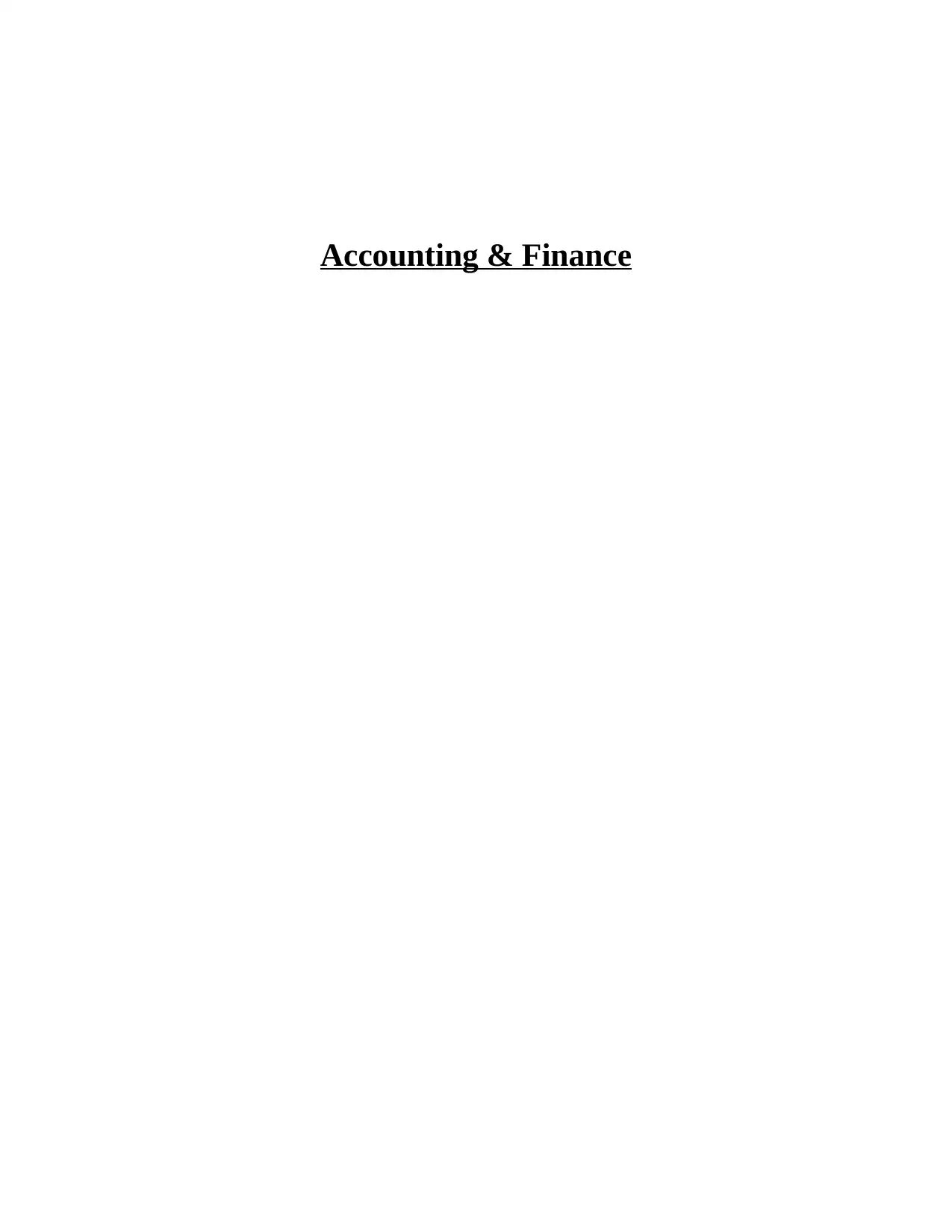
Accounting & Finance
Paraphrase This Document
Need a fresh take? Get an instant paraphrase of this document with our AI Paraphraser
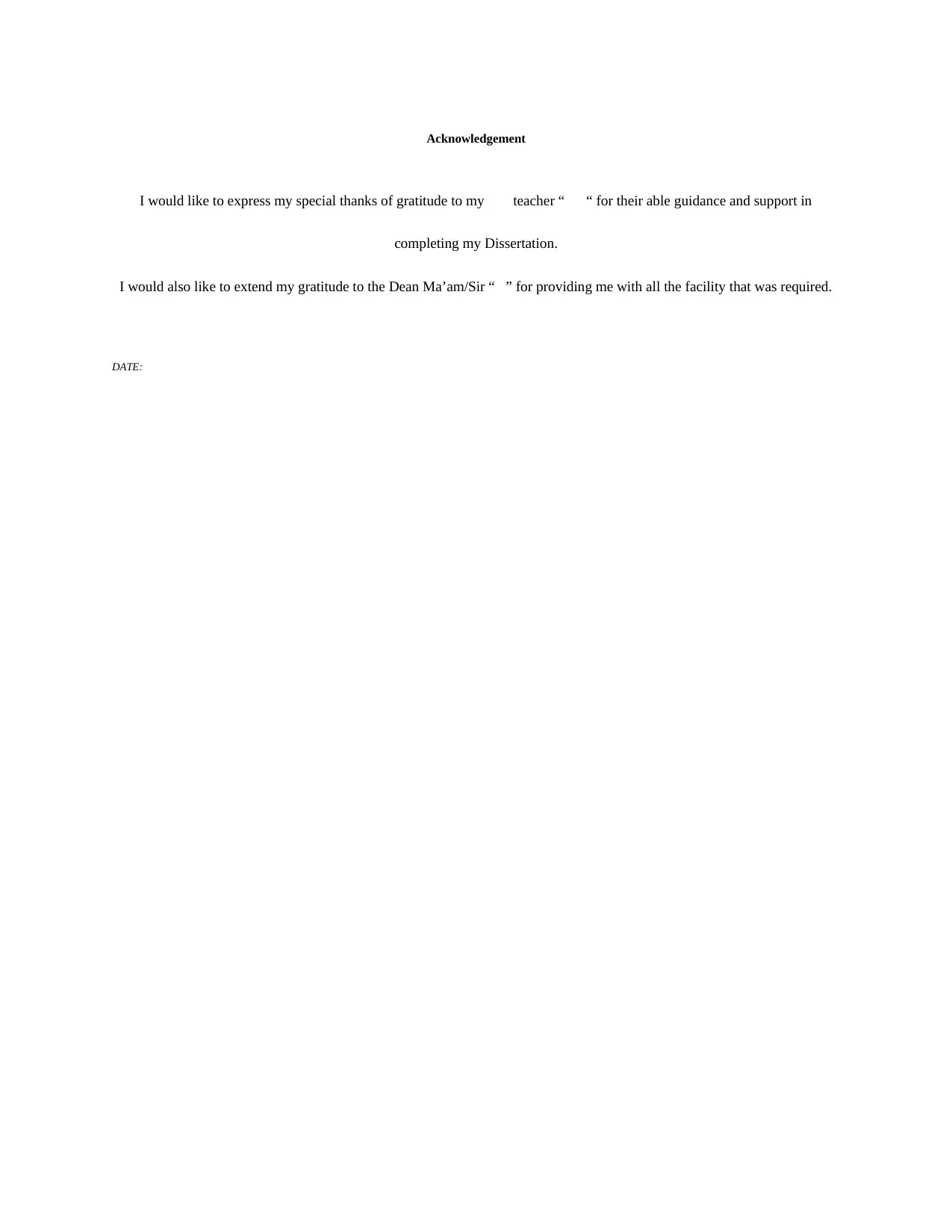
Acknowledgement
I would like to express my special thanks of gratitude to my teacher “ “ for their able guidance and support in
completing my Dissertation.
I would also like to extend my gratitude to the Dean Ma’am/Sir “ ” for providing me with all the facility that was required.
DATE:
I would like to express my special thanks of gratitude to my teacher “ “ for their able guidance and support in
completing my Dissertation.
I would also like to extend my gratitude to the Dean Ma’am/Sir “ ” for providing me with all the facility that was required.
DATE:
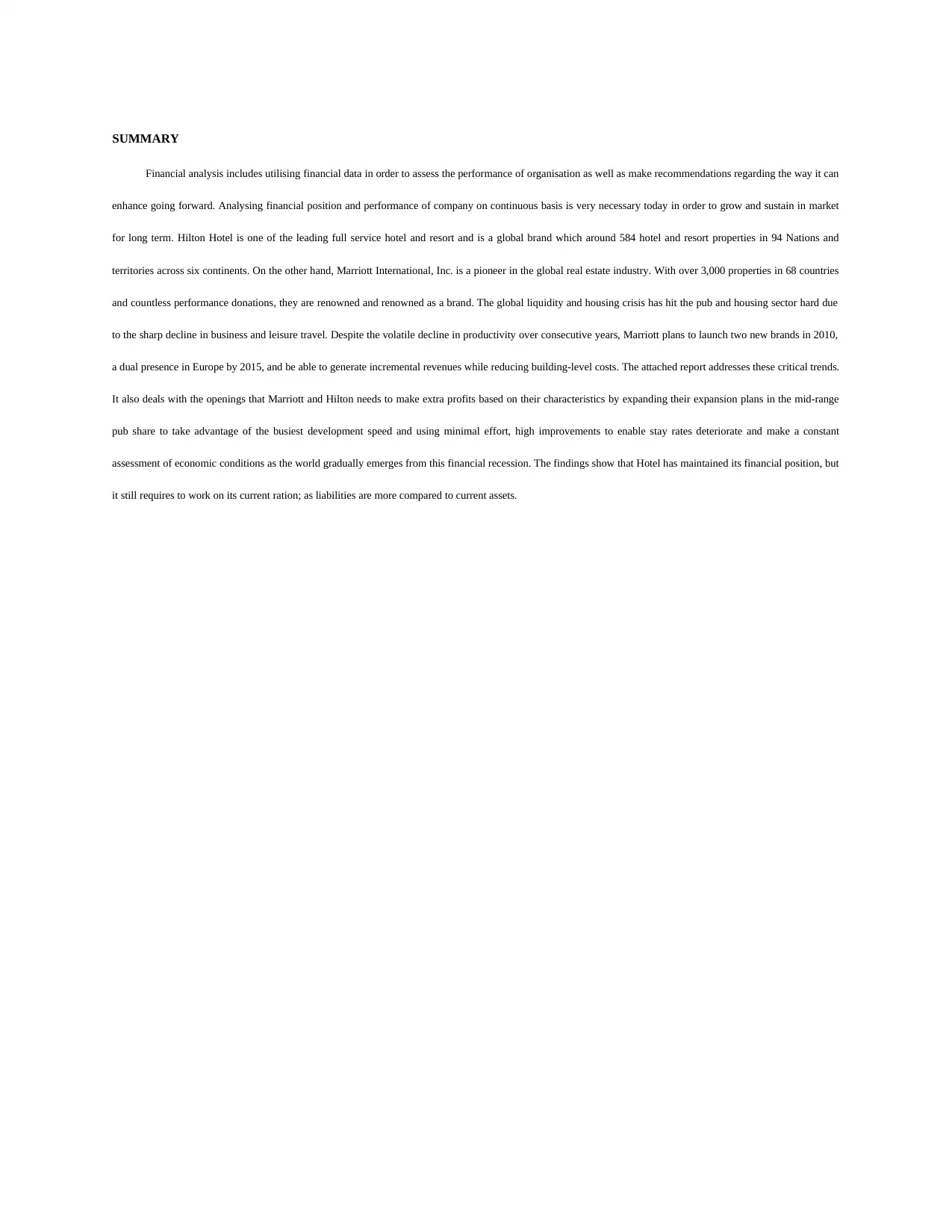
SUMMARY
Financial analysis includes utilising financial data in order to assess the performance of organisation as well as make recommendations regarding the way it can
enhance going forward. Analysing financial position and performance of company on continuous basis is very necessary today in order to grow and sustain in market
for long term. Hilton Hotel is one of the leading full service hotel and resort and is a global brand which around 584 hotel and resort properties in 94 Nations and
territories across six continents. On the other hand, Marriott International, Inc. is a pioneer in the global real estate industry. With over 3,000 properties in 68 countries
and countless performance donations, they are renowned and renowned as a brand. The global liquidity and housing crisis has hit the pub and housing sector hard due
to the sharp decline in business and leisure travel. Despite the volatile decline in productivity over consecutive years, Marriott plans to launch two new brands in 2010,
a dual presence in Europe by 2015, and be able to generate incremental revenues while reducing building-level costs. The attached report addresses these critical trends.
It also deals with the openings that Marriott and Hilton needs to make extra profits based on their characteristics by expanding their expansion plans in the mid-range
pub share to take advantage of the busiest development speed and using minimal effort, high improvements to enable stay rates deteriorate and make a constant
assessment of economic conditions as the world gradually emerges from this financial recession. The findings show that Hotel has maintained its financial position, but
it still requires to work on its current ration; as liabilities are more compared to current assets.
Financial analysis includes utilising financial data in order to assess the performance of organisation as well as make recommendations regarding the way it can
enhance going forward. Analysing financial position and performance of company on continuous basis is very necessary today in order to grow and sustain in market
for long term. Hilton Hotel is one of the leading full service hotel and resort and is a global brand which around 584 hotel and resort properties in 94 Nations and
territories across six continents. On the other hand, Marriott International, Inc. is a pioneer in the global real estate industry. With over 3,000 properties in 68 countries
and countless performance donations, they are renowned and renowned as a brand. The global liquidity and housing crisis has hit the pub and housing sector hard due
to the sharp decline in business and leisure travel. Despite the volatile decline in productivity over consecutive years, Marriott plans to launch two new brands in 2010,
a dual presence in Europe by 2015, and be able to generate incremental revenues while reducing building-level costs. The attached report addresses these critical trends.
It also deals with the openings that Marriott and Hilton needs to make extra profits based on their characteristics by expanding their expansion plans in the mid-range
pub share to take advantage of the busiest development speed and using minimal effort, high improvements to enable stay rates deteriorate and make a constant
assessment of economic conditions as the world gradually emerges from this financial recession. The findings show that Hotel has maintained its financial position, but
it still requires to work on its current ration; as liabilities are more compared to current assets.
⊘ This is a preview!⊘
Do you want full access?
Subscribe today to unlock all pages.

Trusted by 1+ million students worldwide
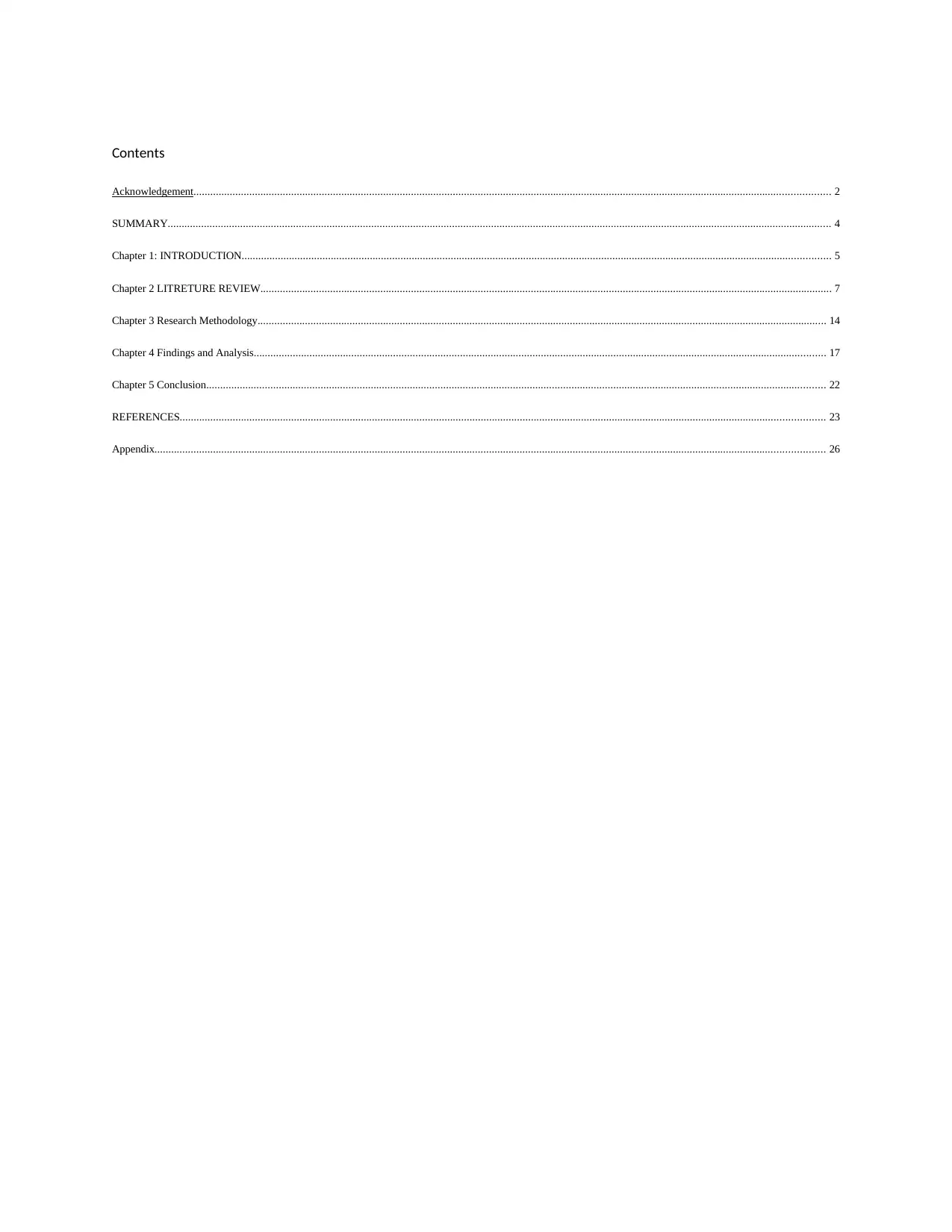
Contents
Acknowledgement.................................................................................................................................................................................................................................... 2
SUMMARY.............................................................................................................................................................................................................................................. 4
Chapter 1: INTRODUCTION................................................................................................................................................................................................................... 5
Chapter 2 LITRETURE REVIEW............................................................................................................................................................................................................. 7
Chapter 3 Research Methodology............................................................................................................................................................................................................ 14
Chapter 4 Findings and Analysis............................................................................................................................................................................................................. 17
Chapter 5 Conclusion.............................................................................................................................................................................................................................. 22
REFERENCES....................................................................................................................................................................................................................................... 23
Appendix................................................................................................................................................................................................................................................ 26
Acknowledgement.................................................................................................................................................................................................................................... 2
SUMMARY.............................................................................................................................................................................................................................................. 4
Chapter 1: INTRODUCTION................................................................................................................................................................................................................... 5
Chapter 2 LITRETURE REVIEW............................................................................................................................................................................................................. 7
Chapter 3 Research Methodology............................................................................................................................................................................................................ 14
Chapter 4 Findings and Analysis............................................................................................................................................................................................................. 17
Chapter 5 Conclusion.............................................................................................................................................................................................................................. 22
REFERENCES....................................................................................................................................................................................................................................... 23
Appendix................................................................................................................................................................................................................................................ 26
Paraphrase This Document
Need a fresh take? Get an instant paraphrase of this document with our AI Paraphraser
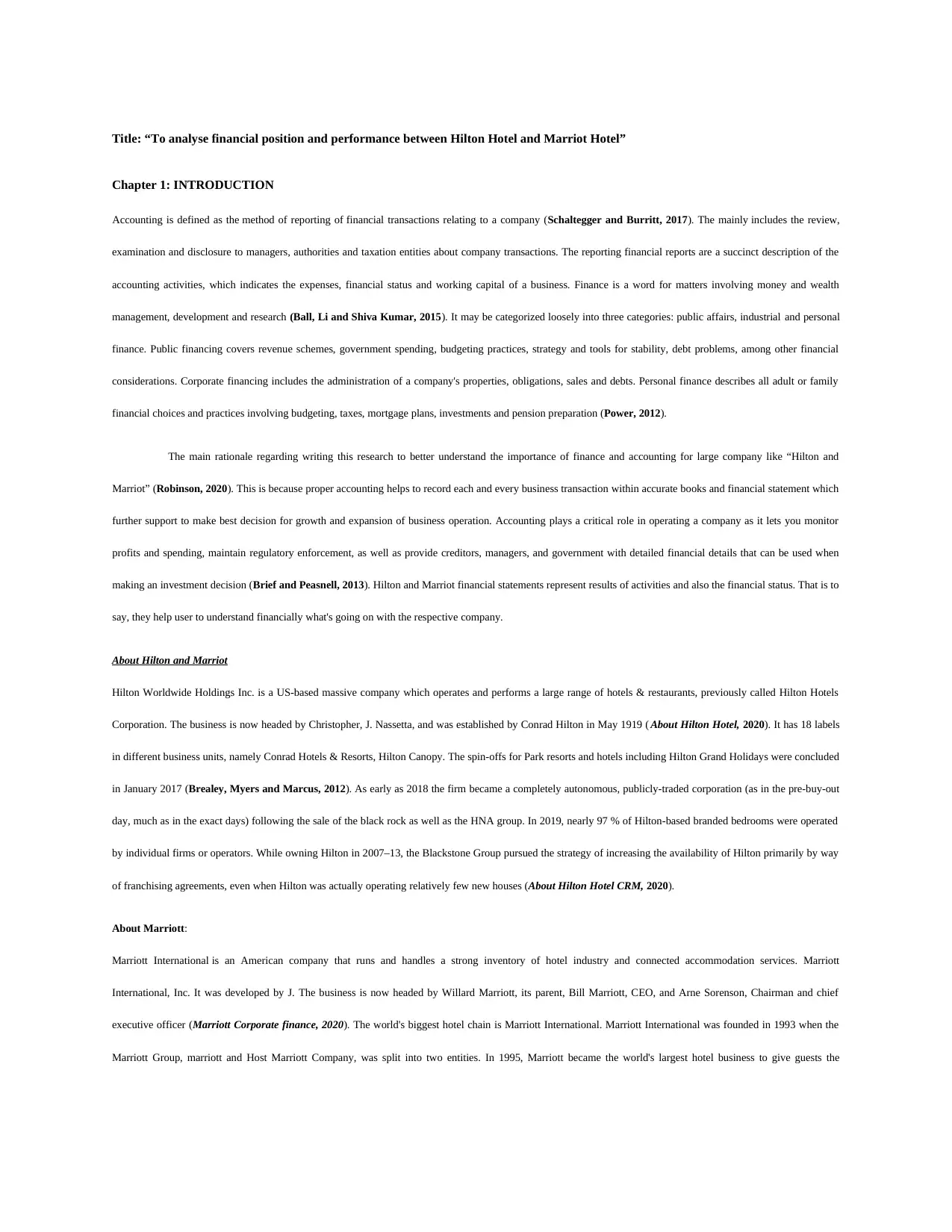
Title: “To analyse financial position and performance between Hilton Hotel and Marriot Hotel”
Chapter 1: INTRODUCTION
Accounting is defined as the method of reporting of financial transactions relating to a company (Schaltegger and Burritt, 2017). The mainly includes the review,
examination and disclosure to managers, authorities and taxation entities about company transactions. The reporting financial reports are a succinct description of the
accounting activities, which indicates the expenses, financial status and working capital of a business. Finance is a word for matters involving money and wealth
management, development and research (Ball, Li and Shiva Kumar, 2015). It may be categorized loosely into three categories: public affairs, industrial and personal
finance. Public financing covers revenue schemes, government spending, budgeting practices, strategy and tools for stability, debt problems, among other financial
considerations. Corporate financing includes the administration of a company's properties, obligations, sales and debts. Personal finance describes all adult or family
financial choices and practices involving budgeting, taxes, mortgage plans, investments and pension preparation (Power, 2012).
The main rationale regarding writing this research to better understand the importance of finance and accounting for large company like “Hilton and
Marriot” (Robinson, 2020). This is because proper accounting helps to record each and every business transaction within accurate books and financial statement which
further support to make best decision for growth and expansion of business operation. Accounting plays a critical role in operating a company as it lets you monitor
profits and spending, maintain regulatory enforcement, as well as provide creditors, managers, and government with detailed financial details that can be used when
making an investment decision (Brief and Peasnell, 2013). Hilton and Marriot financial statements represent results of activities and also the financial status. That is to
say, they help user to understand financially what's going on with the respective company.
About Hilton and Marriot
Hilton Worldwide Holdings Inc. is a US-based massive company which operates and performs a large range of hotels & restaurants, previously called Hilton Hotels
Corporation. The business is now headed by Christopher, J. Nassetta, and was established by Conrad Hilton in May 1919 ( About Hilton Hotel, 2020). It has 18 labels
in different business units, namely Conrad Hotels & Resorts, Hilton Canopy. The spin-offs for Park resorts and hotels including Hilton Grand Holidays were concluded
in January 2017 (Brealey, Myers and Marcus, 2012). As early as 2018 the firm became a completely autonomous, publicly-traded corporation (as in the pre-buy-out
day, much as in the exact days) following the sale of the black rock as well as the HNA group. In 2019, nearly 97 % of Hilton-based branded bedrooms were operated
by individual firms or operators. While owning Hilton in 2007–13, the Blackstone Group pursued the strategy of increasing the availability of Hilton primarily by way
of franchising agreements, even when Hilton was actually operating relatively few new houses (About Hilton Hotel CRM, 2020).
About Marriott:
Marriott International is an American company that runs and handles a strong inventory of hotel industry and connected accommodation services. Marriott
International, Inc. It was developed by J. The business is now headed by Willard Marriott, its parent, Bill Marriott, CEO, and Arne Sorenson, Chairman and chief
executive officer (Marriott Corporate finance, 2020). The world's biggest hotel chain is Marriott International. Marriott International was founded in 1993 when the
Marriott Group, marriott and Host Marriott Company, was split into two entities. In 1995, Marriott became the world's largest hotel business to give guests the
Chapter 1: INTRODUCTION
Accounting is defined as the method of reporting of financial transactions relating to a company (Schaltegger and Burritt, 2017). The mainly includes the review,
examination and disclosure to managers, authorities and taxation entities about company transactions. The reporting financial reports are a succinct description of the
accounting activities, which indicates the expenses, financial status and working capital of a business. Finance is a word for matters involving money and wealth
management, development and research (Ball, Li and Shiva Kumar, 2015). It may be categorized loosely into three categories: public affairs, industrial and personal
finance. Public financing covers revenue schemes, government spending, budgeting practices, strategy and tools for stability, debt problems, among other financial
considerations. Corporate financing includes the administration of a company's properties, obligations, sales and debts. Personal finance describes all adult or family
financial choices and practices involving budgeting, taxes, mortgage plans, investments and pension preparation (Power, 2012).
The main rationale regarding writing this research to better understand the importance of finance and accounting for large company like “Hilton and
Marriot” (Robinson, 2020). This is because proper accounting helps to record each and every business transaction within accurate books and financial statement which
further support to make best decision for growth and expansion of business operation. Accounting plays a critical role in operating a company as it lets you monitor
profits and spending, maintain regulatory enforcement, as well as provide creditors, managers, and government with detailed financial details that can be used when
making an investment decision (Brief and Peasnell, 2013). Hilton and Marriot financial statements represent results of activities and also the financial status. That is to
say, they help user to understand financially what's going on with the respective company.
About Hilton and Marriot
Hilton Worldwide Holdings Inc. is a US-based massive company which operates and performs a large range of hotels & restaurants, previously called Hilton Hotels
Corporation. The business is now headed by Christopher, J. Nassetta, and was established by Conrad Hilton in May 1919 ( About Hilton Hotel, 2020). It has 18 labels
in different business units, namely Conrad Hotels & Resorts, Hilton Canopy. The spin-offs for Park resorts and hotels including Hilton Grand Holidays were concluded
in January 2017 (Brealey, Myers and Marcus, 2012). As early as 2018 the firm became a completely autonomous, publicly-traded corporation (as in the pre-buy-out
day, much as in the exact days) following the sale of the black rock as well as the HNA group. In 2019, nearly 97 % of Hilton-based branded bedrooms were operated
by individual firms or operators. While owning Hilton in 2007–13, the Blackstone Group pursued the strategy of increasing the availability of Hilton primarily by way
of franchising agreements, even when Hilton was actually operating relatively few new houses (About Hilton Hotel CRM, 2020).
About Marriott:
Marriott International is an American company that runs and handles a strong inventory of hotel industry and connected accommodation services. Marriott
International, Inc. It was developed by J. The business is now headed by Willard Marriott, its parent, Bill Marriott, CEO, and Arne Sorenson, Chairman and chief
executive officer (Marriott Corporate finance, 2020). The world's biggest hotel chain is Marriott International. Marriott International was founded in 1993 when the
Marriott Group, marriott and Host Marriott Company, was split into two entities. In 1995, Marriott became the world's largest hotel business to give guests the
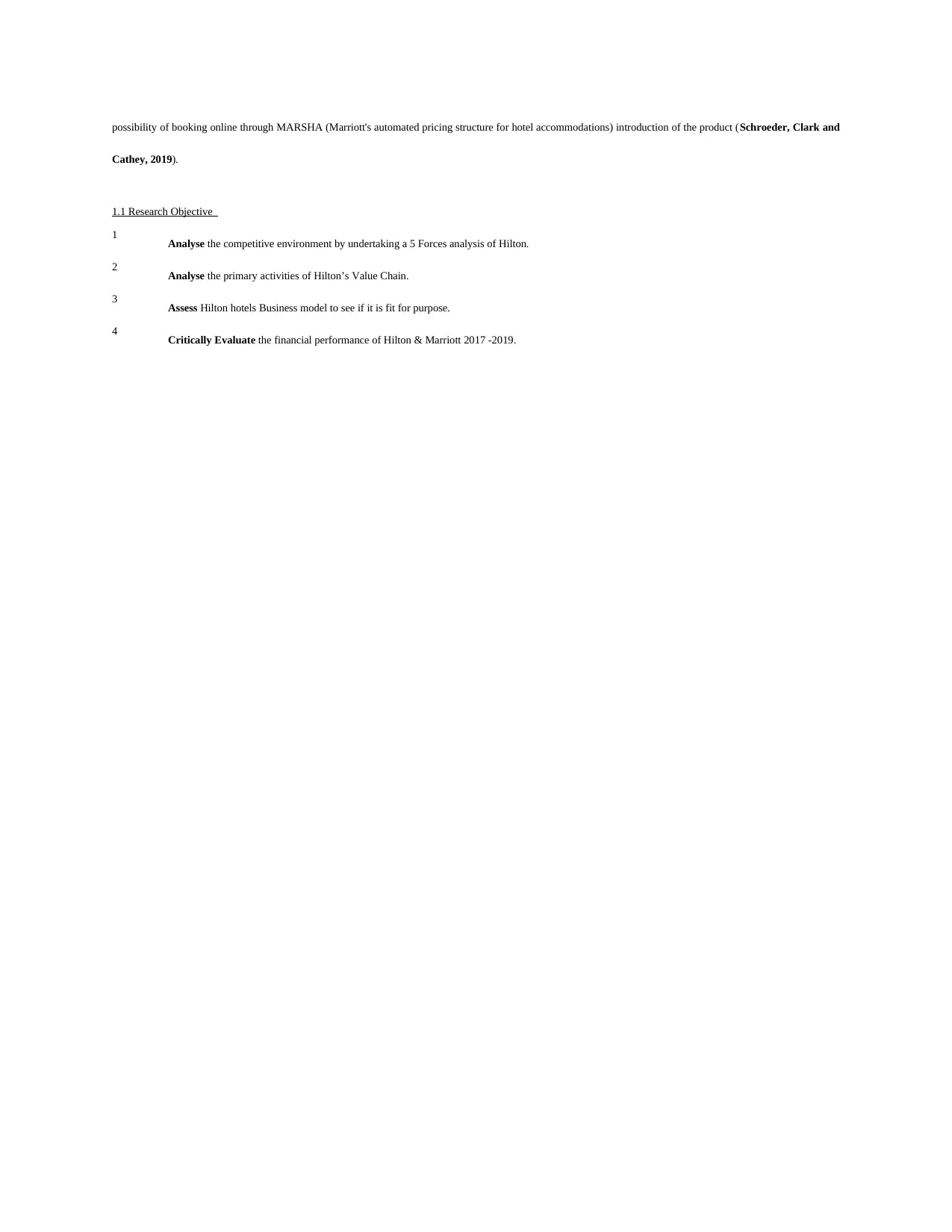
possibility of booking online through MARSHA (Marriott's automated pricing structure for hotel accommodations) introduction of the product (Schroeder, Clark and
Cathey, 2019).
1.1 Research Objective
1 Analyse the competitive environment by undertaking a 5 Forces analysis of Hilton.
2 Analyse the primary activities of Hilton’s Value Chain.
3 Assess Hilton hotels Business model to see if it is fit for purpose.
4 Critically Evaluate the financial performance of Hilton & Marriott 2017 -2019.
Cathey, 2019).
1.1 Research Objective
1 Analyse the competitive environment by undertaking a 5 Forces analysis of Hilton.
2 Analyse the primary activities of Hilton’s Value Chain.
3 Assess Hilton hotels Business model to see if it is fit for purpose.
4 Critically Evaluate the financial performance of Hilton & Marriott 2017 -2019.
⊘ This is a preview!⊘
Do you want full access?
Subscribe today to unlock all pages.

Trusted by 1+ million students worldwide
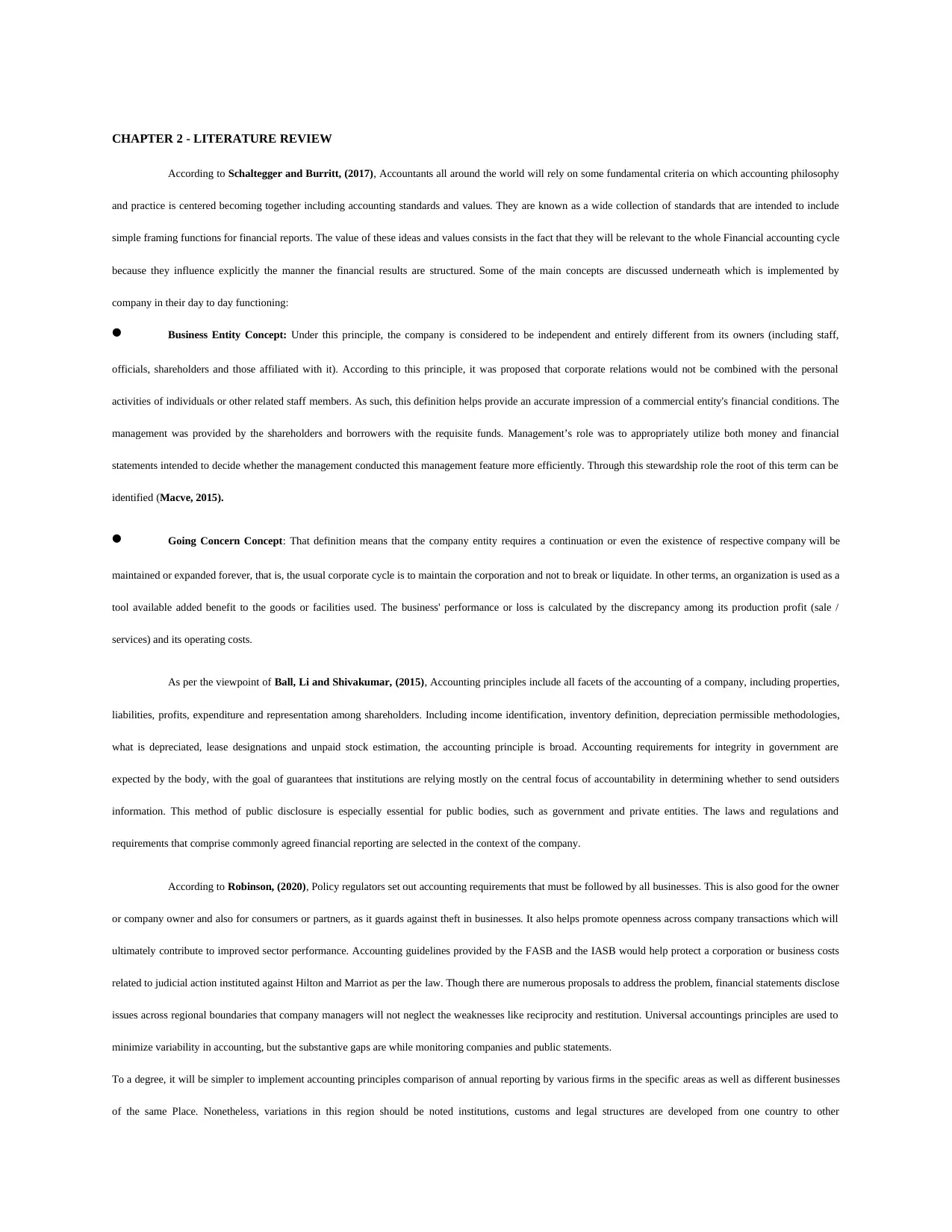
CHAPTER 2 - LITERATURE REVIEW
According to Schaltegger and Burritt, (2017), Accountants all around the world will rely on some fundamental criteria on which accounting philosophy
and practice is centered becoming together including accounting standards and values. They are known as a wide collection of standards that are intended to include
simple framing functions for financial reports. The value of these ideas and values consists in the fact that they will be relevant to the whole Financial accounting cycle
because they influence explicitly the manner the financial results are structured. Some of the main concepts are discussed underneath which is implemented by
company in their day to day functioning:
● Business Entity Concept: Under this principle, the company is considered to be independent and entirely different from its owners (including staff,
officials, shareholders and those affiliated with it). According to this principle, it was proposed that corporate relations would not be combined with the personal
activities of individuals or other related staff members. As such, this definition helps provide an accurate impression of a commercial entity's financial conditions. The
management was provided by the shareholders and borrowers with the requisite funds. Management’s role was to appropriately utilize both money and financial
statements intended to decide whether the management conducted this management feature more efficiently. Through this stewardship role the root of this term can be
identified (Macve, 2015).
● Going Concern Concept: That definition means that the company entity requires a continuation or even the existence of respective company will be
maintained or expanded forever, that is, the usual corporate cycle is to maintain the corporation and not to break or liquidate. In other terms, an organization is used as a
tool available added benefit to the goods or facilities used. The business' performance or loss is calculated by the discrepancy among its production profit (sale /
services) and its operating costs.
As per the viewpoint of Ball, Li and Shivakumar, (2015), Accounting principles include all facets of the accounting of a company, including properties,
liabilities, profits, expenditure and representation among shareholders. Including income identification, inventory definition, depreciation permissible methodologies,
what is depreciated, lease designations and unpaid stock estimation, the accounting principle is broad. Accounting requirements for integrity in government are
expected by the body, with the goal of guarantees that institutions are relying mostly on the central focus of accountability in determining whether to send outsiders
information. This method of public disclosure is especially essential for public bodies, such as government and private entities. The laws and regulations and
requirements that comprise commonly agreed financial reporting are selected in the context of the company.
According to Robinson, (2020), Policy regulators set out accounting requirements that must be followed by all businesses. This is also good for the owner
or company owner and also for consumers or partners, as it guards against theft in businesses. It also helps promote openness across company transactions which will
ultimately contribute to improved sector performance. Accounting guidelines provided by the FASB and the IASB would help protect a corporation or business costs
related to judicial action instituted against Hilton and Marriot as per the law. Though there are numerous proposals to address the problem, financial statements disclose
issues across regional boundaries that company managers will not neglect the weaknesses like reciprocity and restitution. Universal accountings principles are used to
minimize variability in accounting, but the substantive gaps are while monitoring companies and public statements.
To a degree, it will be simpler to implement accounting principles comparison of annual reporting by various firms in the specific areas as well as different businesses
of the same Place. Nonetheless, variations in this region should be noted institutions, customs and legal structures are developed from one country to other
According to Schaltegger and Burritt, (2017), Accountants all around the world will rely on some fundamental criteria on which accounting philosophy
and practice is centered becoming together including accounting standards and values. They are known as a wide collection of standards that are intended to include
simple framing functions for financial reports. The value of these ideas and values consists in the fact that they will be relevant to the whole Financial accounting cycle
because they influence explicitly the manner the financial results are structured. Some of the main concepts are discussed underneath which is implemented by
company in their day to day functioning:
● Business Entity Concept: Under this principle, the company is considered to be independent and entirely different from its owners (including staff,
officials, shareholders and those affiliated with it). According to this principle, it was proposed that corporate relations would not be combined with the personal
activities of individuals or other related staff members. As such, this definition helps provide an accurate impression of a commercial entity's financial conditions. The
management was provided by the shareholders and borrowers with the requisite funds. Management’s role was to appropriately utilize both money and financial
statements intended to decide whether the management conducted this management feature more efficiently. Through this stewardship role the root of this term can be
identified (Macve, 2015).
● Going Concern Concept: That definition means that the company entity requires a continuation or even the existence of respective company will be
maintained or expanded forever, that is, the usual corporate cycle is to maintain the corporation and not to break or liquidate. In other terms, an organization is used as a
tool available added benefit to the goods or facilities used. The business' performance or loss is calculated by the discrepancy among its production profit (sale /
services) and its operating costs.
As per the viewpoint of Ball, Li and Shivakumar, (2015), Accounting principles include all facets of the accounting of a company, including properties,
liabilities, profits, expenditure and representation among shareholders. Including income identification, inventory definition, depreciation permissible methodologies,
what is depreciated, lease designations and unpaid stock estimation, the accounting principle is broad. Accounting requirements for integrity in government are
expected by the body, with the goal of guarantees that institutions are relying mostly on the central focus of accountability in determining whether to send outsiders
information. This method of public disclosure is especially essential for public bodies, such as government and private entities. The laws and regulations and
requirements that comprise commonly agreed financial reporting are selected in the context of the company.
According to Robinson, (2020), Policy regulators set out accounting requirements that must be followed by all businesses. This is also good for the owner
or company owner and also for consumers or partners, as it guards against theft in businesses. It also helps promote openness across company transactions which will
ultimately contribute to improved sector performance. Accounting guidelines provided by the FASB and the IASB would help protect a corporation or business costs
related to judicial action instituted against Hilton and Marriot as per the law. Though there are numerous proposals to address the problem, financial statements disclose
issues across regional boundaries that company managers will not neglect the weaknesses like reciprocity and restitution. Universal accountings principles are used to
minimize variability in accounting, but the substantive gaps are while monitoring companies and public statements.
To a degree, it will be simpler to implement accounting principles comparison of annual reporting by various firms in the specific areas as well as different businesses
of the same Place. Nonetheless, variations in this region should be noted institutions, customs and legal structures are developed from one country to other
Paraphrase This Document
Need a fresh take? Get an instant paraphrase of this document with our AI Paraphraser
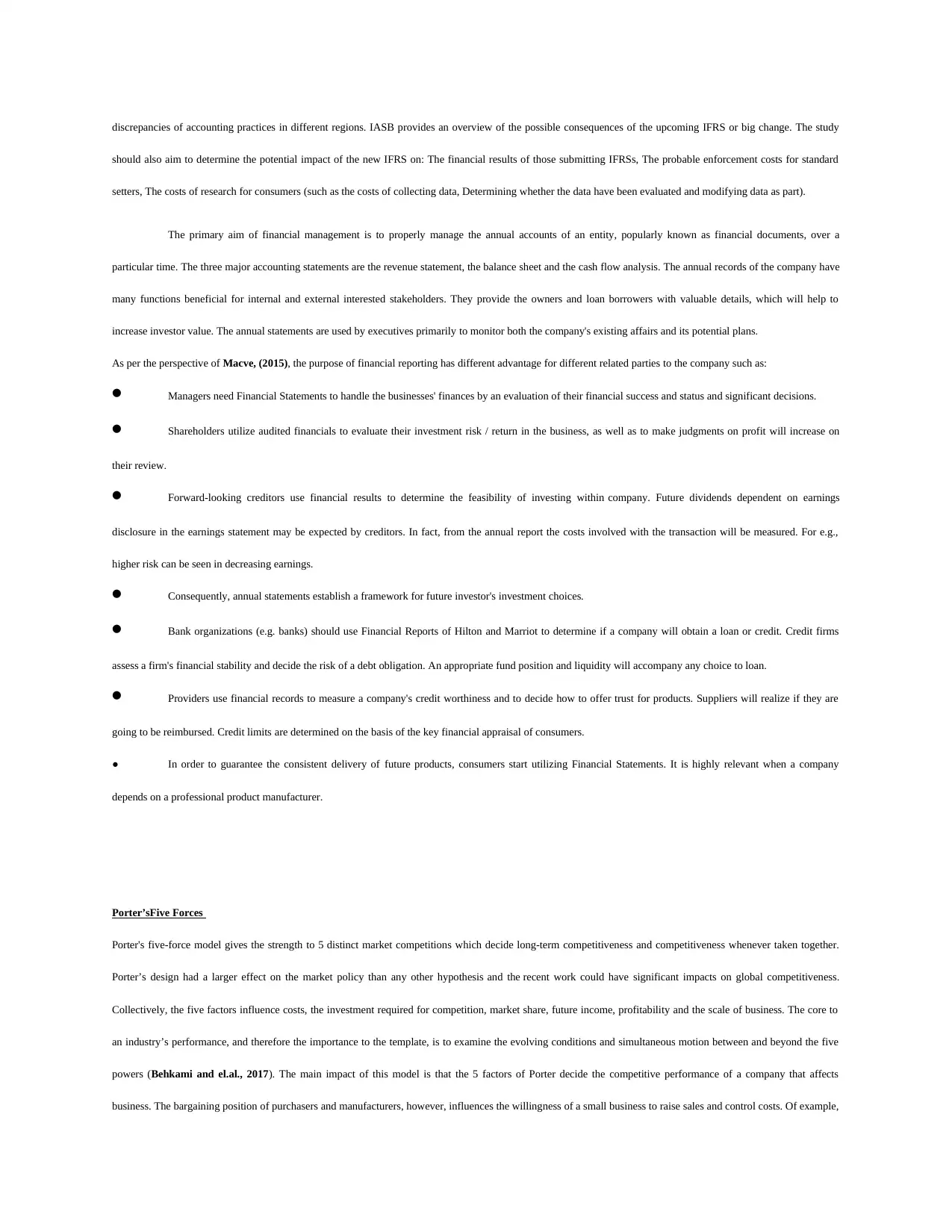
discrepancies of accounting practices in different regions. IASB provides an overview of the possible consequences of the upcoming IFRS or big change. The study
should also aim to determine the potential impact of the new IFRS on: The financial results of those submitting IFRSs, The probable enforcement costs for standard
setters, The costs of research for consumers (such as the costs of collecting data, Determining whether the data have been evaluated and modifying data as part).
The primary aim of financial management is to properly manage the annual accounts of an entity, popularly known as financial documents, over a
particular time. The three major accounting statements are the revenue statement, the balance sheet and the cash flow analysis. The annual records of the company have
many functions beneficial for internal and external interested stakeholders. They provide the owners and loan borrowers with valuable details, which will help to
increase investor value. The annual statements are used by executives primarily to monitor both the company's existing affairs and its potential plans.
As per the perspective of Macve, (2015), the purpose of financial reporting has different advantage for different related parties to the company such as:
● Managers need Financial Statements to handle the businesses' finances by an evaluation of their financial success and status and significant decisions.
● Shareholders utilize audited financials to evaluate their investment risk / return in the business, as well as to make judgments on profit will increase on
their review.
● Forward-looking creditors use financial results to determine the feasibility of investing within company. Future dividends dependent on earnings
disclosure in the earnings statement may be expected by creditors. In fact, from the annual report the costs involved with the transaction will be measured. For e.g.,
higher risk can be seen in decreasing earnings.
● Consequently, annual statements establish a framework for future investor's investment choices.
● Bank organizations (e.g. banks) should use Financial Reports of Hilton and Marriot to determine if a company will obtain a loan or credit. Credit firms
assess a firm's financial stability and decide the risk of a debt obligation. An appropriate fund position and liquidity will accompany any choice to loan.
● Providers use financial records to measure a company's credit worthiness and to decide how to offer trust for products. Suppliers will realize if they are
going to be reimbursed. Credit limits are determined on the basis of the key financial appraisal of consumers.
● In order to guarantee the consistent delivery of future products, consumers start utilizing Financial Statements. It is highly relevant when a company
depends on a professional product manufacturer.
Porter’sFive Forces
Porter's five-force model gives the strength to 5 distinct market competitions which decide long-term competitiveness and competitiveness whenever taken together.
Porter’s design had a larger effect on the market policy than any other hypothesis and the recent work could have significant impacts on global competitiveness.
Collectively, the five factors influence costs, the investment required for competition, market share, future income, profitability and the scale of business. The core to
an industry’s performance, and therefore the importance to the template, is to examine the evolving conditions and simultaneous motion between and beyond the five
powers (Behkami and el.al., 2017). The main impact of this model is that the 5 factors of Porter decide the competitive performance of a company that affects
business. The bargaining position of purchasers and manufacturers, however, influences the willingness of a small business to raise sales and control costs. Of example,
should also aim to determine the potential impact of the new IFRS on: The financial results of those submitting IFRSs, The probable enforcement costs for standard
setters, The costs of research for consumers (such as the costs of collecting data, Determining whether the data have been evaluated and modifying data as part).
The primary aim of financial management is to properly manage the annual accounts of an entity, popularly known as financial documents, over a
particular time. The three major accounting statements are the revenue statement, the balance sheet and the cash flow analysis. The annual records of the company have
many functions beneficial for internal and external interested stakeholders. They provide the owners and loan borrowers with valuable details, which will help to
increase investor value. The annual statements are used by executives primarily to monitor both the company's existing affairs and its potential plans.
As per the perspective of Macve, (2015), the purpose of financial reporting has different advantage for different related parties to the company such as:
● Managers need Financial Statements to handle the businesses' finances by an evaluation of their financial success and status and significant decisions.
● Shareholders utilize audited financials to evaluate their investment risk / return in the business, as well as to make judgments on profit will increase on
their review.
● Forward-looking creditors use financial results to determine the feasibility of investing within company. Future dividends dependent on earnings
disclosure in the earnings statement may be expected by creditors. In fact, from the annual report the costs involved with the transaction will be measured. For e.g.,
higher risk can be seen in decreasing earnings.
● Consequently, annual statements establish a framework for future investor's investment choices.
● Bank organizations (e.g. banks) should use Financial Reports of Hilton and Marriot to determine if a company will obtain a loan or credit. Credit firms
assess a firm's financial stability and decide the risk of a debt obligation. An appropriate fund position and liquidity will accompany any choice to loan.
● Providers use financial records to measure a company's credit worthiness and to decide how to offer trust for products. Suppliers will realize if they are
going to be reimbursed. Credit limits are determined on the basis of the key financial appraisal of consumers.
● In order to guarantee the consistent delivery of future products, consumers start utilizing Financial Statements. It is highly relevant when a company
depends on a professional product manufacturer.
Porter’sFive Forces
Porter's five-force model gives the strength to 5 distinct market competitions which decide long-term competitiveness and competitiveness whenever taken together.
Porter’s design had a larger effect on the market policy than any other hypothesis and the recent work could have significant impacts on global competitiveness.
Collectively, the five factors influence costs, the investment required for competition, market share, future income, profitability and the scale of business. The core to
an industry’s performance, and therefore the importance to the template, is to examine the evolving conditions and simultaneous motion between and beyond the five
powers (Behkami and el.al., 2017). The main impact of this model is that the 5 factors of Porter decide the competitive performance of a company that affects
business. The bargaining position of purchasers and manufacturers, however, influences the willingness of a small business to raise sales and control costs. Of example,
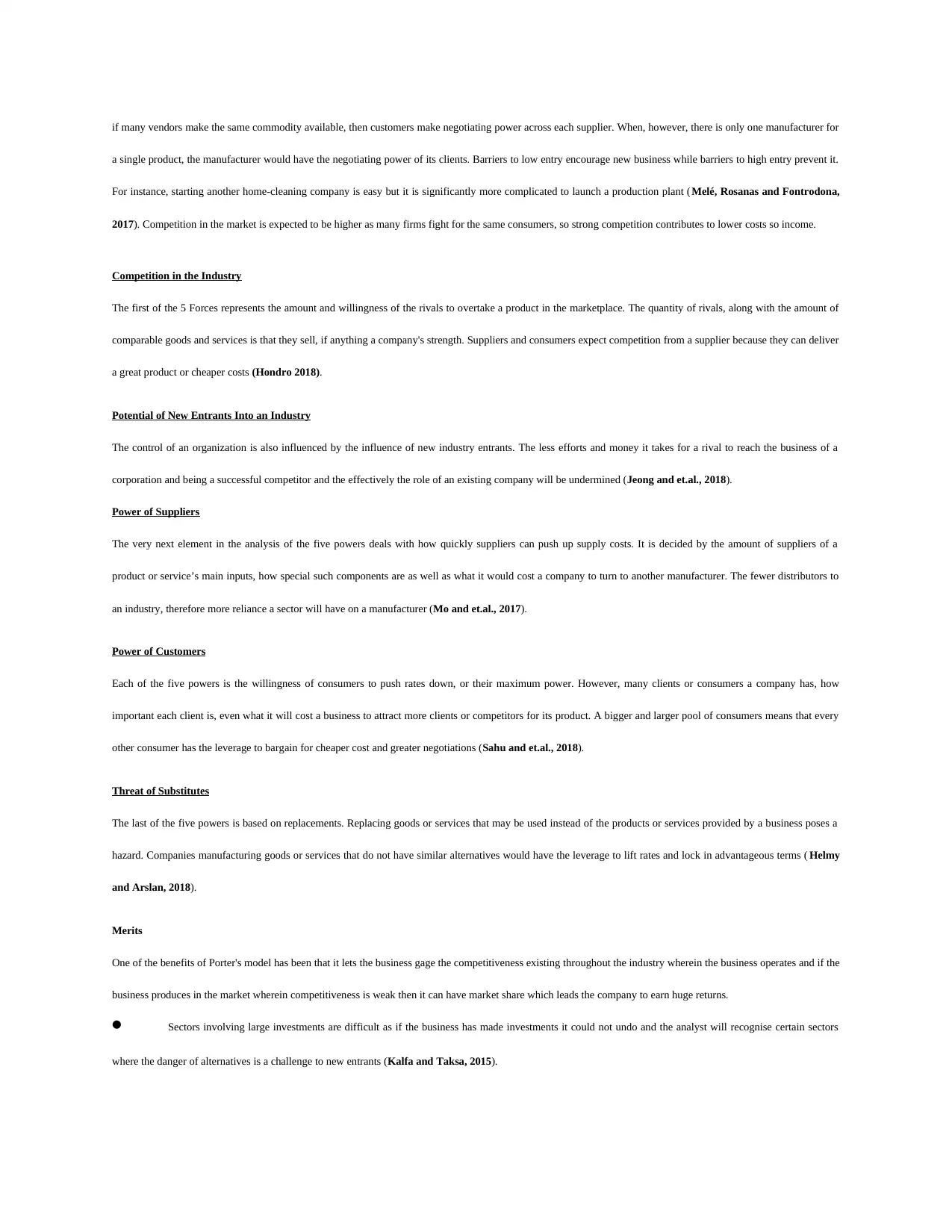
if many vendors make the same commodity available, then customers make negotiating power across each supplier. When, however, there is only one manufacturer for
a single product, the manufacturer would have the negotiating power of its clients. Barriers to low entry encourage new business while barriers to high entry prevent it.
For instance, starting another home-cleaning company is easy but it is significantly more complicated to launch a production plant ( Melé, Rosanas and Fontrodona,
2017). Competition in the market is expected to be higher as many firms fight for the same consumers, so strong competition contributes to lower costs so income.
Competition in the Industry
The first of the 5 Forces represents the amount and willingness of the rivals to overtake a product in the marketplace. The quantity of rivals, along with the amount of
comparable goods and services is that they sell, if anything a company's strength. Suppliers and consumers expect competition from a supplier because they can deliver
a great product or cheaper costs (Hondro 2018).
Potential of New Entrants Into an Industry
The control of an organization is also influenced by the influence of new industry entrants. The less efforts and money it takes for a rival to reach the business of a
corporation and being a successful competitor and the effectively the role of an existing company will be undermined (Jeong and et.al., 2018).
Power of Suppliers
The very next element in the analysis of the five powers deals with how quickly suppliers can push up supply costs. It is decided by the amount of suppliers of a
product or service’s main inputs, how special such components are as well as what it would cost a company to turn to another manufacturer. The fewer distributors to
an industry, therefore more reliance a sector will have on a manufacturer (Mo and et.al., 2017).
Power of Customers
Each of the five powers is the willingness of consumers to push rates down, or their maximum power. However, many clients or consumers a company has, how
important each client is, even what it will cost a business to attract more clients or competitors for its product. A bigger and larger pool of consumers means that every
other consumer has the leverage to bargain for cheaper cost and greater negotiations (Sahu and et.al., 2018).
Threat of Substitutes
The last of the five powers is based on replacements. Replacing goods or services that may be used instead of the products or services provided by a business poses a
hazard. Companies manufacturing goods or services that do not have similar alternatives would have the leverage to lift rates and lock in advantageous terms ( Helmy
and Arslan, 2018).
Merits
One of the benefits of Porter's model has been that it lets the business gage the competitiveness existing throughout the industry wherein the business operates and if the
business produces in the market wherein competitiveness is weak then it can have market share which leads the company to earn huge returns.
● Sectors involving large investments are difficult as if the business has made investments it could not undo and the analyst will recognise certain sectors
where the danger of alternatives is a challenge to new entrants (Kalfa and Taksa, 2015).
a single product, the manufacturer would have the negotiating power of its clients. Barriers to low entry encourage new business while barriers to high entry prevent it.
For instance, starting another home-cleaning company is easy but it is significantly more complicated to launch a production plant ( Melé, Rosanas and Fontrodona,
2017). Competition in the market is expected to be higher as many firms fight for the same consumers, so strong competition contributes to lower costs so income.
Competition in the Industry
The first of the 5 Forces represents the amount and willingness of the rivals to overtake a product in the marketplace. The quantity of rivals, along with the amount of
comparable goods and services is that they sell, if anything a company's strength. Suppliers and consumers expect competition from a supplier because they can deliver
a great product or cheaper costs (Hondro 2018).
Potential of New Entrants Into an Industry
The control of an organization is also influenced by the influence of new industry entrants. The less efforts and money it takes for a rival to reach the business of a
corporation and being a successful competitor and the effectively the role of an existing company will be undermined (Jeong and et.al., 2018).
Power of Suppliers
The very next element in the analysis of the five powers deals with how quickly suppliers can push up supply costs. It is decided by the amount of suppliers of a
product or service’s main inputs, how special such components are as well as what it would cost a company to turn to another manufacturer. The fewer distributors to
an industry, therefore more reliance a sector will have on a manufacturer (Mo and et.al., 2017).
Power of Customers
Each of the five powers is the willingness of consumers to push rates down, or their maximum power. However, many clients or consumers a company has, how
important each client is, even what it will cost a business to attract more clients or competitors for its product. A bigger and larger pool of consumers means that every
other consumer has the leverage to bargain for cheaper cost and greater negotiations (Sahu and et.al., 2018).
Threat of Substitutes
The last of the five powers is based on replacements. Replacing goods or services that may be used instead of the products or services provided by a business poses a
hazard. Companies manufacturing goods or services that do not have similar alternatives would have the leverage to lift rates and lock in advantageous terms ( Helmy
and Arslan, 2018).
Merits
One of the benefits of Porter's model has been that it lets the business gage the competitiveness existing throughout the industry wherein the business operates and if the
business produces in the market wherein competitiveness is weak then it can have market share which leads the company to earn huge returns.
● Sectors involving large investments are difficult as if the business has made investments it could not undo and the analyst will recognise certain sectors
where the danger of alternatives is a challenge to new entrants (Kalfa and Taksa, 2015).
⊘ This is a preview!⊘
Do you want full access?
Subscribe today to unlock all pages.

Trusted by 1+ million students worldwide
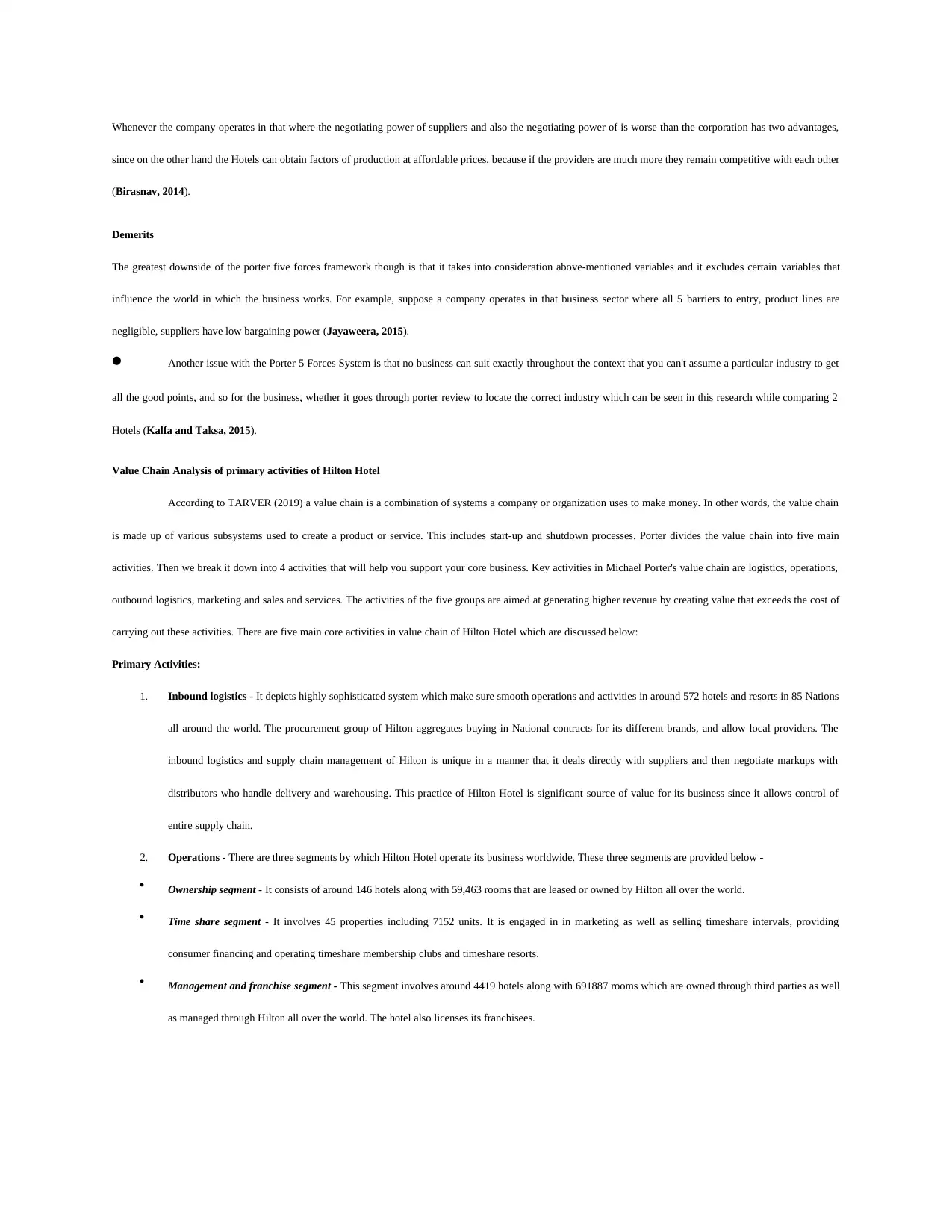
Whenever the company operates in that where the negotiating power of suppliers and also the negotiating power of is worse than the corporation has two advantages,
since on the other hand the Hotels can obtain factors of production at affordable prices, because if the providers are much more they remain competitive with each other
(Birasnav, 2014).
Demerits
The greatest downside of the porter five forces framework though is that it takes into consideration above-mentioned variables and it excludes certain variables that
influence the world in which the business works. For example, suppose a company operates in that business sector where all 5 barriers to entry, product lines are
negligible, suppliers have low bargaining power (Jayaweera, 2015).
● Another issue with the Porter 5 Forces System is that no business can suit exactly throughout the context that you can't assume a particular industry to get
all the good points, and so for the business, whether it goes through porter review to locate the correct industry which can be seen in this research while comparing 2
Hotels (Kalfa and Taksa, 2015).
Value Chain Analysis of primary activities of Hilton Hotel
According to TARVER (2019) a value chain is a combination of systems a company or organization uses to make money. In other words, the value chain
is made up of various subsystems used to create a product or service. This includes start-up and shutdown processes. Porter divides the value chain into five main
activities. Then we break it down into 4 activities that will help you support your core business. Key activities in Michael Porter's value chain are logistics, operations,
outbound logistics, marketing and sales and services. The activities of the five groups are aimed at generating higher revenue by creating value that exceeds the cost of
carrying out these activities. There are five main core activities in value chain of Hilton Hotel which are discussed below:
Primary Activities:
1. Inbound logistics - It depicts highly sophisticated system which make sure smooth operations and activities in around 572 hotels and resorts in 85 Nations
all around the world. The procurement group of Hilton aggregates buying in National contracts for its different brands, and allow local providers. The
inbound logistics and supply chain management of Hilton is unique in a manner that it deals directly with suppliers and then negotiate markups with
distributors who handle delivery and warehousing. This practice of Hilton Hotel is significant source of value for its business since it allows control of
entire supply chain.
2. Operations - There are three segments by which Hilton Hotel operate its business worldwide. These three segments are provided below -
Ownership segment - It consists of around 146 hotels along with 59,463 rooms that are leased or owned by Hilton all over the world.
Time share segment - It involves 45 properties including 7152 units. It is engaged in in marketing as well as selling timeshare intervals, providing
consumer financing and operating timeshare membership clubs and timeshare resorts.
Management and franchise segment - This segment involves around 4419 hotels along with 691887 rooms which are owned through third parties as well
as managed through Hilton all over the world. The hotel also licenses its franchisees.
since on the other hand the Hotels can obtain factors of production at affordable prices, because if the providers are much more they remain competitive with each other
(Birasnav, 2014).
Demerits
The greatest downside of the porter five forces framework though is that it takes into consideration above-mentioned variables and it excludes certain variables that
influence the world in which the business works. For example, suppose a company operates in that business sector where all 5 barriers to entry, product lines are
negligible, suppliers have low bargaining power (Jayaweera, 2015).
● Another issue with the Porter 5 Forces System is that no business can suit exactly throughout the context that you can't assume a particular industry to get
all the good points, and so for the business, whether it goes through porter review to locate the correct industry which can be seen in this research while comparing 2
Hotels (Kalfa and Taksa, 2015).
Value Chain Analysis of primary activities of Hilton Hotel
According to TARVER (2019) a value chain is a combination of systems a company or organization uses to make money. In other words, the value chain
is made up of various subsystems used to create a product or service. This includes start-up and shutdown processes. Porter divides the value chain into five main
activities. Then we break it down into 4 activities that will help you support your core business. Key activities in Michael Porter's value chain are logistics, operations,
outbound logistics, marketing and sales and services. The activities of the five groups are aimed at generating higher revenue by creating value that exceeds the cost of
carrying out these activities. There are five main core activities in value chain of Hilton Hotel which are discussed below:
Primary Activities:
1. Inbound logistics - It depicts highly sophisticated system which make sure smooth operations and activities in around 572 hotels and resorts in 85 Nations
all around the world. The procurement group of Hilton aggregates buying in National contracts for its different brands, and allow local providers. The
inbound logistics and supply chain management of Hilton is unique in a manner that it deals directly with suppliers and then negotiate markups with
distributors who handle delivery and warehousing. This practice of Hilton Hotel is significant source of value for its business since it allows control of
entire supply chain.
2. Operations - There are three segments by which Hilton Hotel operate its business worldwide. These three segments are provided below -
Ownership segment - It consists of around 146 hotels along with 59,463 rooms that are leased or owned by Hilton all over the world.
Time share segment - It involves 45 properties including 7152 units. It is engaged in in marketing as well as selling timeshare intervals, providing
consumer financing and operating timeshare membership clubs and timeshare resorts.
Management and franchise segment - This segment involves around 4419 hotels along with 691887 rooms which are owned through third parties as well
as managed through Hilton all over the world. The hotel also licenses its franchisees.
Paraphrase This Document
Need a fresh take? Get an instant paraphrase of this document with our AI Paraphraser
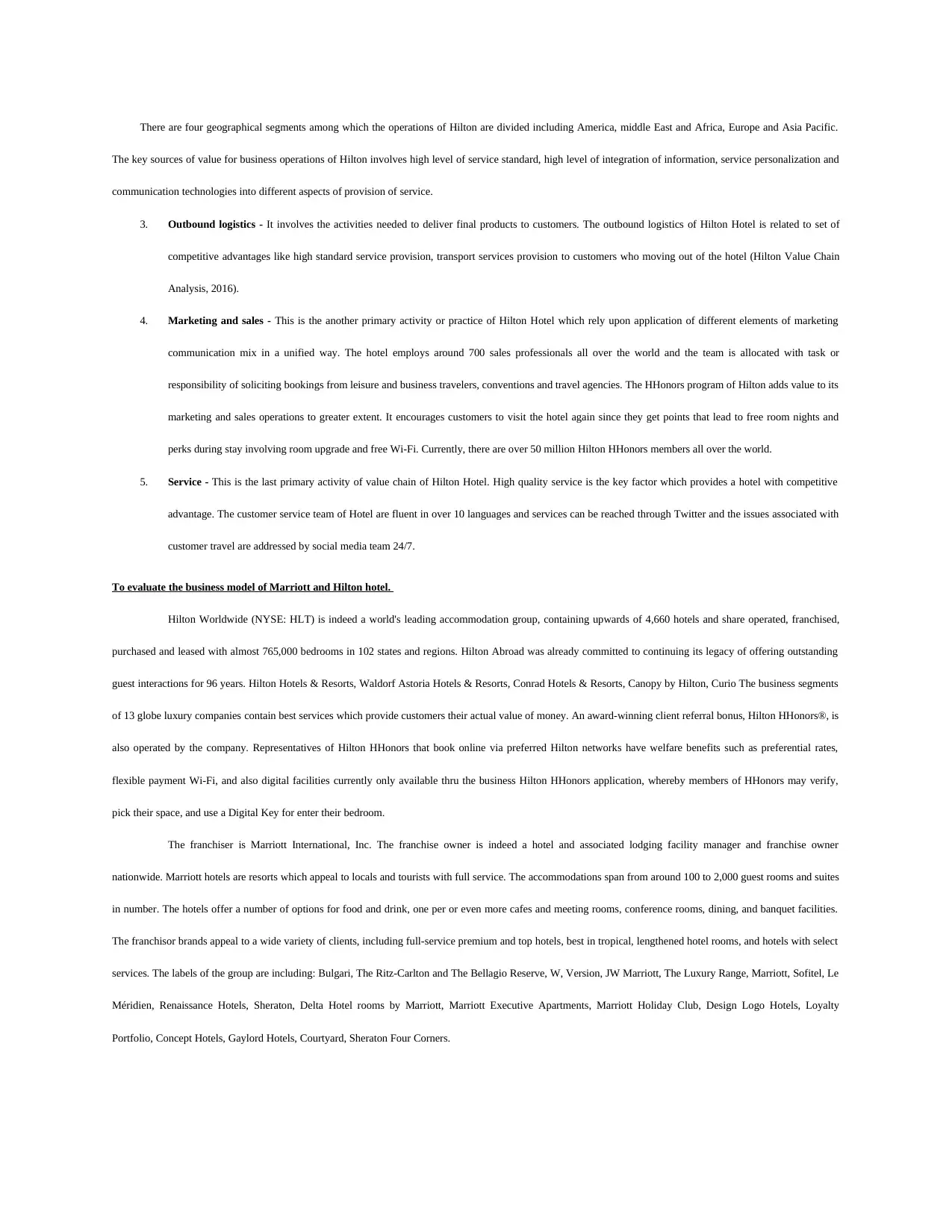
There are four geographical segments among which the operations of Hilton are divided including America, middle East and Africa, Europe and Asia Pacific.
The key sources of value for business operations of Hilton involves high level of service standard, high level of integration of information, service personalization and
communication technologies into different aspects of provision of service.
3. Outbound logistics - It involves the activities needed to deliver final products to customers. The outbound logistics of Hilton Hotel is related to set of
competitive advantages like high standard service provision, transport services provision to customers who moving out of the hotel (Hilton Value Chain
Analysis, 2016).
4. Marketing and sales - This is the another primary activity or practice of Hilton Hotel which rely upon application of different elements of marketing
communication mix in a unified way. The hotel employs around 700 sales professionals all over the world and the team is allocated with task or
responsibility of soliciting bookings from leisure and business travelers, conventions and travel agencies. The HHonors program of Hilton adds value to its
marketing and sales operations to greater extent. It encourages customers to visit the hotel again since they get points that lead to free room nights and
perks during stay involving room upgrade and free Wi-Fi. Currently, there are over 50 million Hilton HHonors members all over the world.
5. Service - This is the last primary activity of value chain of Hilton Hotel. High quality service is the key factor which provides a hotel with competitive
advantage. The customer service team of Hotel are fluent in over 10 languages and services can be reached through Twitter and the issues associated with
customer travel are addressed by social media team 24/7.
To evaluate the business model of Marriott and Hilton hotel.
Hilton Worldwide (NYSE: HLT) is indeed a world's leading accommodation group, containing upwards of 4,660 hotels and share operated, franchised,
purchased and leased with almost 765,000 bedrooms in 102 states and regions. Hilton Abroad was already committed to continuing its legacy of offering outstanding
guest interactions for 96 years. Hilton Hotels & Resorts, Waldorf Astoria Hotels & Resorts, Conrad Hotels & Resorts, Canopy by Hilton, Curio The business segments
of 13 globe luxury companies contain best services which provide customers their actual value of money. An award-winning client referral bonus, Hilton HHonors®, is
also operated by the company. Representatives of Hilton HHonors that book online via preferred Hilton networks have welfare benefits such as preferential rates,
flexible payment Wi-Fi, and also digital facilities currently only available thru the business Hilton HHonors application, whereby members of HHonors may verify,
pick their space, and use a Digital Key for enter their bedroom.
The franchiser is Marriott International, Inc. The franchise owner is indeed a hotel and associated lodging facility manager and franchise owner
nationwide. Marriott hotels are resorts which appeal to locals and tourists with full service. The accommodations span from around 100 to 2,000 guest rooms and suites
in number. The hotels offer a number of options for food and drink, one per or even more cafes and meeting rooms, conference rooms, dining, and banquet facilities.
The franchisor brands appeal to a wide variety of clients, including full-service premium and top hotels, best in tropical, lengthened hotel rooms, and hotels with select
services. The labels of the group are including: Bulgari, The Ritz-Carlton and The Bellagio Reserve, W, Version, JW Marriott, The Luxury Range, Marriott, Sofitel, Le
Méridien, Renaissance Hotels, Sheraton, Delta Hotel rooms by Marriott, Marriott Executive Apartments, Marriott Holiday Club, Design Logo Hotels, Loyalty
Portfolio, Concept Hotels, Gaylord Hotels, Courtyard, Sheraton Four Corners.
The key sources of value for business operations of Hilton involves high level of service standard, high level of integration of information, service personalization and
communication technologies into different aspects of provision of service.
3. Outbound logistics - It involves the activities needed to deliver final products to customers. The outbound logistics of Hilton Hotel is related to set of
competitive advantages like high standard service provision, transport services provision to customers who moving out of the hotel (Hilton Value Chain
Analysis, 2016).
4. Marketing and sales - This is the another primary activity or practice of Hilton Hotel which rely upon application of different elements of marketing
communication mix in a unified way. The hotel employs around 700 sales professionals all over the world and the team is allocated with task or
responsibility of soliciting bookings from leisure and business travelers, conventions and travel agencies. The HHonors program of Hilton adds value to its
marketing and sales operations to greater extent. It encourages customers to visit the hotel again since they get points that lead to free room nights and
perks during stay involving room upgrade and free Wi-Fi. Currently, there are over 50 million Hilton HHonors members all over the world.
5. Service - This is the last primary activity of value chain of Hilton Hotel. High quality service is the key factor which provides a hotel with competitive
advantage. The customer service team of Hotel are fluent in over 10 languages and services can be reached through Twitter and the issues associated with
customer travel are addressed by social media team 24/7.
To evaluate the business model of Marriott and Hilton hotel.
Hilton Worldwide (NYSE: HLT) is indeed a world's leading accommodation group, containing upwards of 4,660 hotels and share operated, franchised,
purchased and leased with almost 765,000 bedrooms in 102 states and regions. Hilton Abroad was already committed to continuing its legacy of offering outstanding
guest interactions for 96 years. Hilton Hotels & Resorts, Waldorf Astoria Hotels & Resorts, Conrad Hotels & Resorts, Canopy by Hilton, Curio The business segments
of 13 globe luxury companies contain best services which provide customers their actual value of money. An award-winning client referral bonus, Hilton HHonors®, is
also operated by the company. Representatives of Hilton HHonors that book online via preferred Hilton networks have welfare benefits such as preferential rates,
flexible payment Wi-Fi, and also digital facilities currently only available thru the business Hilton HHonors application, whereby members of HHonors may verify,
pick their space, and use a Digital Key for enter their bedroom.
The franchiser is Marriott International, Inc. The franchise owner is indeed a hotel and associated lodging facility manager and franchise owner
nationwide. Marriott hotels are resorts which appeal to locals and tourists with full service. The accommodations span from around 100 to 2,000 guest rooms and suites
in number. The hotels offer a number of options for food and drink, one per or even more cafes and meeting rooms, conference rooms, dining, and banquet facilities.
The franchisor brands appeal to a wide variety of clients, including full-service premium and top hotels, best in tropical, lengthened hotel rooms, and hotels with select
services. The labels of the group are including: Bulgari, The Ritz-Carlton and The Bellagio Reserve, W, Version, JW Marriott, The Luxury Range, Marriott, Sofitel, Le
Méridien, Renaissance Hotels, Sheraton, Delta Hotel rooms by Marriott, Marriott Executive Apartments, Marriott Holiday Club, Design Logo Hotels, Loyalty
Portfolio, Concept Hotels, Gaylord Hotels, Courtyard, Sheraton Four Corners.
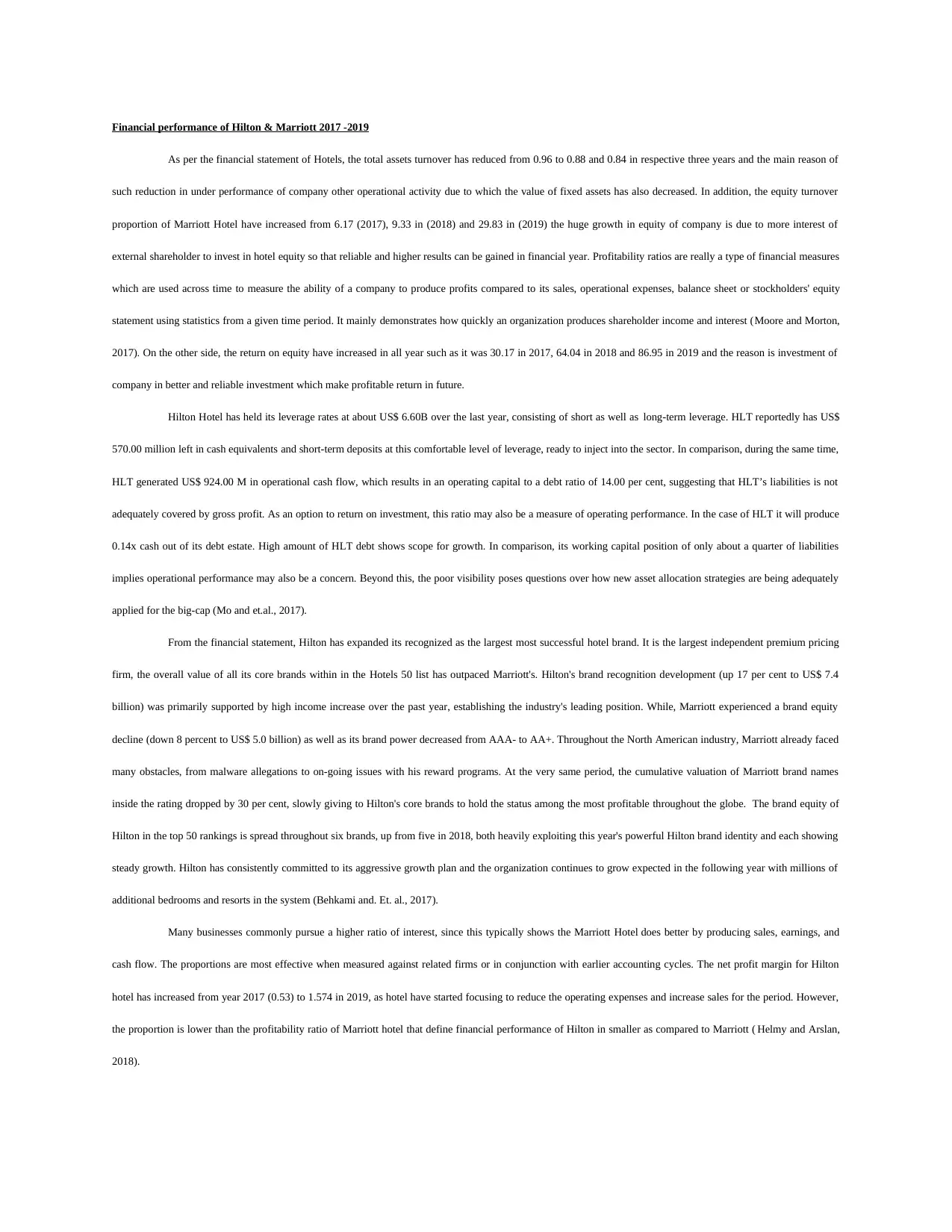
Financial performance of Hilton & Marriott 2017 -2019
As per the financial statement of Hotels, the total assets turnover has reduced from 0.96 to 0.88 and 0.84 in respective three years and the main reason of
such reduction in under performance of company other operational activity due to which the value of fixed assets has also decreased. In addition, the equity turnover
proportion of Marriott Hotel have increased from 6.17 (2017), 9.33 in (2018) and 29.83 in (2019) the huge growth in equity of company is due to more interest of
external shareholder to invest in hotel equity so that reliable and higher results can be gained in financial year. Profitability ratios are really a type of financial measures
which are used across time to measure the ability of a company to produce profits compared to its sales, operational expenses, balance sheet or stockholders' equity
statement using statistics from a given time period. It mainly demonstrates how quickly an organization produces shareholder income and interest (Moore and Morton,
2017). On the other side, the return on equity have increased in all year such as it was 30.17 in 2017, 64.04 in 2018 and 86.95 in 2019 and the reason is investment of
company in better and reliable investment which make profitable return in future.
Hilton Hotel has held its leverage rates at about US$ 6.60B over the last year, consisting of short as well as long-term leverage. HLT reportedly has US$
570.00 million left in cash equivalents and short-term deposits at this comfortable level of leverage, ready to inject into the sector. In comparison, during the same time,
HLT generated US$ 924.00 M in operational cash flow, which results in an operating capital to a debt ratio of 14.00 per cent, suggesting that HLT’s liabilities is not
adequately covered by gross profit. As an option to return on investment, this ratio may also be a measure of operating performance. In the case of HLT it will produce
0.14x cash out of its debt estate. High amount of HLT debt shows scope for growth. In comparison, its working capital position of only about a quarter of liabilities
implies operational performance may also be a concern. Beyond this, the poor visibility poses questions over how new asset allocation strategies are being adequately
applied for the big-cap (Mo and et.al., 2017).
From the financial statement, Hilton has expanded its recognized as the largest most successful hotel brand. It is the largest independent premium pricing
firm, the overall value of all its core brands within in the Hotels 50 list has outpaced Marriott's. Hilton's brand recognition development (up 17 per cent to US$ 7.4
billion) was primarily supported by high income increase over the past year, establishing the industry's leading position. While, Marriott experienced a brand equity
decline (down 8 percent to US$ 5.0 billion) as well as its brand power decreased from AAA- to AA+. Throughout the North American industry, Marriott already faced
many obstacles, from malware allegations to on-going issues with his reward programs. At the very same period, the cumulative valuation of Marriott brand names
inside the rating dropped by 30 per cent, slowly giving to Hilton's core brands to hold the status among the most profitable throughout the globe. The brand equity of
Hilton in the top 50 rankings is spread throughout six brands, up from five in 2018, both heavily exploiting this year's powerful Hilton brand identity and each showing
steady growth. Hilton has consistently committed to its aggressive growth plan and the organization continues to grow expected in the following year with millions of
additional bedrooms and resorts in the system (Behkami and. Et. al., 2017).
Many businesses commonly pursue a higher ratio of interest, since this typically shows the Marriott Hotel does better by producing sales, earnings, and
cash flow. The proportions are most effective when measured against related firms or in conjunction with earlier accounting cycles. The net profit margin for Hilton
hotel has increased from year 2017 (0.53) to 1.574 in 2019, as hotel have started focusing to reduce the operating expenses and increase sales for the period. However,
the proportion is lower than the profitability ratio of Marriott hotel that define financial performance of Hilton in smaller as compared to Marriott ( Helmy and Arslan,
2018).
As per the financial statement of Hotels, the total assets turnover has reduced from 0.96 to 0.88 and 0.84 in respective three years and the main reason of
such reduction in under performance of company other operational activity due to which the value of fixed assets has also decreased. In addition, the equity turnover
proportion of Marriott Hotel have increased from 6.17 (2017), 9.33 in (2018) and 29.83 in (2019) the huge growth in equity of company is due to more interest of
external shareholder to invest in hotel equity so that reliable and higher results can be gained in financial year. Profitability ratios are really a type of financial measures
which are used across time to measure the ability of a company to produce profits compared to its sales, operational expenses, balance sheet or stockholders' equity
statement using statistics from a given time period. It mainly demonstrates how quickly an organization produces shareholder income and interest (Moore and Morton,
2017). On the other side, the return on equity have increased in all year such as it was 30.17 in 2017, 64.04 in 2018 and 86.95 in 2019 and the reason is investment of
company in better and reliable investment which make profitable return in future.
Hilton Hotel has held its leverage rates at about US$ 6.60B over the last year, consisting of short as well as long-term leverage. HLT reportedly has US$
570.00 million left in cash equivalents and short-term deposits at this comfortable level of leverage, ready to inject into the sector. In comparison, during the same time,
HLT generated US$ 924.00 M in operational cash flow, which results in an operating capital to a debt ratio of 14.00 per cent, suggesting that HLT’s liabilities is not
adequately covered by gross profit. As an option to return on investment, this ratio may also be a measure of operating performance. In the case of HLT it will produce
0.14x cash out of its debt estate. High amount of HLT debt shows scope for growth. In comparison, its working capital position of only about a quarter of liabilities
implies operational performance may also be a concern. Beyond this, the poor visibility poses questions over how new asset allocation strategies are being adequately
applied for the big-cap (Mo and et.al., 2017).
From the financial statement, Hilton has expanded its recognized as the largest most successful hotel brand. It is the largest independent premium pricing
firm, the overall value of all its core brands within in the Hotels 50 list has outpaced Marriott's. Hilton's brand recognition development (up 17 per cent to US$ 7.4
billion) was primarily supported by high income increase over the past year, establishing the industry's leading position. While, Marriott experienced a brand equity
decline (down 8 percent to US$ 5.0 billion) as well as its brand power decreased from AAA- to AA+. Throughout the North American industry, Marriott already faced
many obstacles, from malware allegations to on-going issues with his reward programs. At the very same period, the cumulative valuation of Marriott brand names
inside the rating dropped by 30 per cent, slowly giving to Hilton's core brands to hold the status among the most profitable throughout the globe. The brand equity of
Hilton in the top 50 rankings is spread throughout six brands, up from five in 2018, both heavily exploiting this year's powerful Hilton brand identity and each showing
steady growth. Hilton has consistently committed to its aggressive growth plan and the organization continues to grow expected in the following year with millions of
additional bedrooms and resorts in the system (Behkami and. Et. al., 2017).
Many businesses commonly pursue a higher ratio of interest, since this typically shows the Marriott Hotel does better by producing sales, earnings, and
cash flow. The proportions are most effective when measured against related firms or in conjunction with earlier accounting cycles. The net profit margin for Hilton
hotel has increased from year 2017 (0.53) to 1.574 in 2019, as hotel have started focusing to reduce the operating expenses and increase sales for the period. However,
the proportion is lower than the profitability ratio of Marriott hotel that define financial performance of Hilton in smaller as compared to Marriott ( Helmy and Arslan,
2018).
⊘ This is a preview!⊘
Do you want full access?
Subscribe today to unlock all pages.

Trusted by 1+ million students worldwide
1 out of 22
Related Documents
Your All-in-One AI-Powered Toolkit for Academic Success.
+13062052269
info@desklib.com
Available 24*7 on WhatsApp / Email
![[object Object]](/_next/static/media/star-bottom.7253800d.svg)
Unlock your academic potential
Copyright © 2020–2025 A2Z Services. All Rights Reserved. Developed and managed by ZUCOL.





